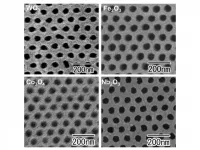(Press-News.org) (COLUMBUS, Ohio) - High-powered magnets are small, shiny magnets made from powerful rare earth metals. Since they started showing up in children's toys in the early 2000s and then later in desk sets in 2009, high-powered magnets have caused thousands of injuries and are considered to be among the most dangerous ingestion hazards in children.
When more than one is swallowed, these high-powered magnets attract to each other across tissue, cutting off blood supply to the bowel and causing obstructions, tissue necrosis, sepsis and even death. The U.S. Consumer Product Safety Commission (CPSC) found them dangerous enough that in 2012 they halted the sale of high-powered magnet sets and instituted a recall followed by a federal rule that effectively eliminated the sale of these products. This rule was overturned by the U.S. Court of Appeals in December 2016.
A recent study led by researchers at the Center for Injury Research and Policy, Emergency Medicine, and the Central Ohio Poison Center at Nationwide Children's Hospital along with the Children's Hospital at Montefiore (CHAM) analyzed calls to U.S. poison centers for magnet exposures in children age 19 years and younger from 2008 through October 2019 to determine the impact of the CPSC rule and the subsequent lift of the ban.
The study, recently published in Journal of Pediatrics, found that the average number of cases per year decreased 33% from 2012 to 2017 after high-powered magnet sets were removed from the market. When the ban was lifted and high-powered magnet sets re-entered the market, the average number of cases per year increased 444%. There was also a 355% increase in the number of cases that were serious enough to require treatment in a hospital. Cases from 2018 and 2019 increased across all age groups and accounted for 39% of magnet cases since 2008.
"Regulations on these products were effective, and the dramatic increase in the number of high-powered magnet related injuries since the ban was lifted - even compared to pre-ban numbers - is alarming," said Leah Middelberg, MD, lead author of the study and emergency medicine physician at Nationwide Children's. "Parents don't always know if their child swallowed something or what they swallowed - they just know their child is uncomfortable - so when children are brought in, an exam and sometimes x-rays are needed to determine what's happening. Because damage caused by magnets can be serious, it's so important to keep these kinds of magnets out of reach of children, and ideally out of the home."
The study found a total of 5,738 magnet exposures during the nearly 12-year study period. Most calls were for children who were male (55%), younger than six years (62%), with an unintentional injury (84%). Approximately one-half (48.4%) of patients were treated at a hospital or other healthcare facility while 48.7% were managed at a non-healthcare site such as a home, workplace, or school. Children in older age groups were more likely than younger children to be admitted to the hospital.
"While many cases occur among young children, parents need to be aware that high-powered magnets are a risk for teenagers as well," said Bryan Rudolph, MD, MPH, co-senior author of this study and gastroenterologist at CHAM. "Serious injuries can happen when teens use these products to mimic tongue or lip piercings. If there are children or teens who live in or frequently visit your home, don't buy these products. If you have high-powered magnets in your home, throw them away. The risk of serious injury is too great."
"Significant increases in magnet injuries correspond to time periods in which high-powered magnet sets were sold, including a 444% increase since 2018," said Middelberg. "These data reflect the urgent need to protect children by preventive measures and government action," Rudolph emphasized. Both Middelberg and Rudolph support the federal legislation, "Magnet Injury Prevention Act," which would limit the strength and/or size of magnets sold as part of a set, as well as reinstatement of a CPSC federal safety standard that would effectively restrict the sale of these magnet products in the U.S.
INFORMATION:
Data for this study were obtained from the National Poison Data System, which is maintained by the American Association of Poison Control Centers (AAPCC). The AAPCC receives data on calls to regional poison control centers that serve the US and its territories. Poison control centers receive phone calls through the Poison Help Line and document information about the product involved, route of exposure, individual exposed, medical outcome, and other data.
The Center for Injury Research and Policy (CIRP) of the Abigail Wexner Research Institute at Nationwide Children's Hospital works globally to reduce injury-related pediatric death and disabilities. With innovative research at its core, CIRP works to continually improve the scientific understanding of the epidemiology, biomechanics, prevention, acute treatment, and rehabilitation of injuries. CIRP serves as a pioneer by translating cutting edge injury research into education, policy, and advances in clinical care. For related injury prevention materials or to learn more about CIRP, visit http://www.injurycenter.org. Follow CIRP on Twitter @CIRPatNCH.
The Central Ohio Poison Center provides state-of-the-art poison prevention, assessment, and treatment to residents in 64 of Ohio's 88 counties. The center services are available to the public, medical professionals, industry, and human service agencies. The Poison Center handles more than 42,000 poison exposure calls annually, and confidential, free emergency poisoning treatment advice is available 24/7. To learn more about the Poison Center, visit http://www.bepoisonsmart.org.
-30-
Middelberg, L. K., Funk, A. R., Hays, H. L., McKenzie, L. B., Rudolph, B., & Spiller, H. A. (2021). Magnet Injuries in Children: An Analysis of the National Poison Data System From 2008-2019. The Journal of Pediatrics, 0(0).
https://doi.org/10.1016/j.jpeds.2021.01.052
A fear of poor SATs results is driving headteachers to separate pupils by ability despite the impact on children's self-esteem and confidence, according to a study by researchers from UCL published in the peer-reviewed British Journal of Sociology of Education.
The findings, based on a survey of nearly 300 principals of primary schools in England, provide new evidence of a high-stakes culture around testing where some pupils are prioritised above others and physically segregated from them.
More than a third (35%) of headteachers said SATs were the reason for grouping children into different ability sets for English, and just under half (47%) for maths, according to the results which also ...
In the world of neurodevelopment, one thing is clear: the earlier the intervention the better. Infancy is a critical time in brain development, and neuroscientists are increasingly identifying factors that can negatively impact cognition and ones that can improve cognition early in life. At the annual meeting of the Cognitive Neuroscience Society (CNS), researchers from the University of Minnesota are presenting new work on two early interventions: one on the potential use of engineered gut microbes for antibiotic-exposed infants and another on a choline supplement to treat infants exposed prenatally to alcohol.
"These talks underscore how patient-based neuroscience can advance ...
Men experiencing vital exhaustion are more likely to have a heart attack, according to research presented today at ESC Acute CardioVascular Care 2021, an online scientific congress of the European Society of Cardiology (ESC).1 The risk of a myocardial infarction linked with exhaustion was particularly pronounced in never married, divorced and widowed men.
"Vital exhaustion refers to excessive fatigue, feelings of demoralisation and increased irritability," said study author Dr. Dmitriy Panov of the Institute of Cytology and Genetics, Novosibirsk, Russian Federation. "It is thought to be a response to intractable problems in people's lives, particularly when they are unable to adapt to prolonged ...
Tokyo, Japan - Scientists from Tokyo Metropolitan University have developed a new method for making ordered arrays of nanoholes in metallic oxide thin films using a range of transition metals. The team used a template to pre-pattern metallic surfaces with an ordered array of dimples before applying electrochemistry to selectively grow an oxide layer with holes. The process makes a wider selection of ordered transition metal nanohole arrays available for new catalysis, filtration, and sensing applications.
A key challenge of nanotechnology is getting control over the structure of materials at the nanoscale. In the search for materials that are porous at this length scale, the field of electrochemistry offers a particularly elegant ...
MRI scanning can more precisely define and detect head, neck, thoracic, abdominal and spinal malformations in unborn babies, finds a large multidisciplinary study led by King's College London with Evelina London Children's Hospital, Great Ormond Street Hospital and UCL.
In the study, published today in Lancet Child and Adolescent Health, the team of researchers and clinicians demonstrate the ways that MRI scanning can show malformations in great detail, including their effect on surrounding structures. Importantly, they note that MRI is a very safe procedure for pregnant women and their babies.
They say the work is invaluable both to clinicians caring for babies before they are born and for teams planning care of the baby after delivery.
Recent research has concentrated ...
The Affordable Care Act (ACA) dramatically increased children's preventive healthcare while reducing out-of-pocket costs, according to a new Boston University School of Public Health (BUSPH) study.
Published in JAMA Network Open, the study found that checkups with out-of-pocket costs dropped from 54.2% of visits in 2010 (the year the ACA passed) to 14.5% in 2018.
"This is a great feather in the cap of the ACA, even though there is still some work to do," says study lead author Dr. Paul Shafer, assistant professor of health law, policy & management at BUSPH.
"We found ...
MIAMI--A new study lead by scientists at the University of Miami (UM) Rosenstiel School of Marine and Atmospheric Science demonstrates that under realistic environmental conditions oil drifting in the ocean after the DWH oil spill photooxidized into persistent compounds within hours to days, instead over long periods of time as was thought during the 2010 Deepwater Horizon oil spill. This is the first model results to support the new paradigm of photooxidation that emerged from laboratory research.
After an oil spill, oil droplets on the ocean surface ...
Cancer cells can dodge chemotherapy by entering a state that bears similarity to certain kinds of senescence, a type of "active hibernation" that enables them to weather the stress induced by aggressive treatments aimed at destroying them, according to a new study by scientists at Weill Cornell Medicine. These findings have implications for developing new drug combinations that could block senescence and make chemotherapy more effective.
In a study published Jan. 26 in Cancer Discovery, a journal of the American Association for Cancer Research, the investigators reported that this biologic process could help explain why cancers so often recur after treatment. The research was done in both organoids and mouse models ...
A study of the relationship between temperature and yields of various rice varieties, based on 50 years of weather and rice-yield data from farms in the Philippines, suggests that warming temperatures negatively affect rice yields.
Recent varieties of rice, bred for environmental stresses like heat, showed better yields than both traditional rice varieties and modern varieties of rice that were not specifically bred to withstand warmer temperatures. But the study found that warming adversely affected crop yields even for those varieties best suited to the heat. Overall, the advantage of varieties bred to withstand increased heat was too small to be statistically significant.
One of ...
Intake of a high-fat diet leads to an increased risk for obesity, type 2 diabetes, cardiovascular diseases and fatty liver. A study in mice from Karolinska Institutet in Sweden shows that it is possible to eliminate the deleterious effects of a high-fat diet by lowering the levels of apolipoprotein CIII (apoCIII), a key regulator of lipid metabolism. The study is published in the journal Science Advances.
Increased levels of the protein apoCIII are related to cardiovascular diseases, insulin resistance and type 2 diabetes. Researchers at the Rolf Luft Research ...

